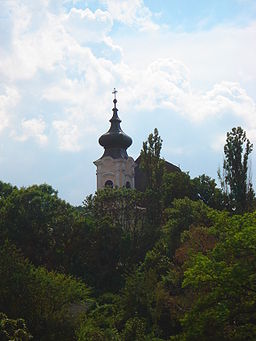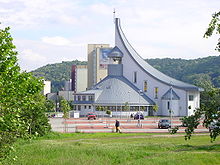- Dúbravka, Bratislava
-
Dúbravka Borough Country Slovakia Region Bratislava District Bratislava IV Elevation 243 m (797 ft) Coordinates 48°11′12″N 17°02′14″E / 48.18667°N 17.03722°E Area 8.649 km2 (3.339 sq mi) Population 34,540 (2005) Density 3,994 / km2 (10,344 / sq mi) First mentioned 1576 Postal code 84102 Area code +421-02 Car plate BA, BL Website: www.dubravka.sk Source[1] Dúbravka is a borough of Bratislava, Slovakia. It lies in the western part of the city on the eastern slope of Devínska Kobyla hill, covers 862 ha and is home to some 35,000 inhabitants.
Contents
History
Old Dúbravka was a separate small town already in existence in the 14th century; at that time it was an administrative part of Devín. It was first mentioned in written documents in 1576 (once occupied by Croats). It was later mentioned in a 1683 text, while Vienna was occupied by the Ottoman Empire. During the Napoleonic and Austro-Prussian wars it was sacked and burned (1866). Dúbravka was incorporated into Bratislava in 1946 as the capital was beginning to expand. Since the 1970s, the construction of apartment blocks has continued.
Population
The older generations of Croat-descended inhabitants have maintained their own dialect until the present day. Otherwise, their habits and way of life resemble those of the Záhorie people (a region north-west of Bratislava). The people of Dúbravka used to earn their living by working in agriculture, especially producing wine. Their goods were sold to the markets of Bratislava and Vienna.
Religion
The church is located in M. Ch. Trnavský Street. The building's maintenance has been sponsored by the Roman Catholic Church, mostly from fundraising and financial donations from churchgoers. One million Slovak Koruna was given by the municipal government. The foundations of the building were sanctified by the Holy Father John Paul II during his visit to Slovakia in Šaštín. This began the history of the new church. The church has an unusual design with an unconventional roof shape; it is 30 metres high and has the shape of a circle. It includes both the temple and the pastor's sector. It was designed by Ing. Arch. Ľudovít Režuch and Ing. Arch. Marián Lupták, who also designed the interior. The capacity of the church is about 600 people. The most effective aspects of the church are its simplicity and efficiency. The sound distribution quality is very high due to the building design, as well as the arrangement of the loud-speakers.
Famous people
- Gustáv Husák, president of Czechoslovakia, was born here on 10 October 1913.
References
External links
- Official website (Slovak)
Gallery
-
Local ice hockey stadium
 Boroughs of Bratislava by districtCategories:
Boroughs of Bratislava by districtCategories:- Boroughs of Bratislava
Wikimedia Foundation. 2010.









